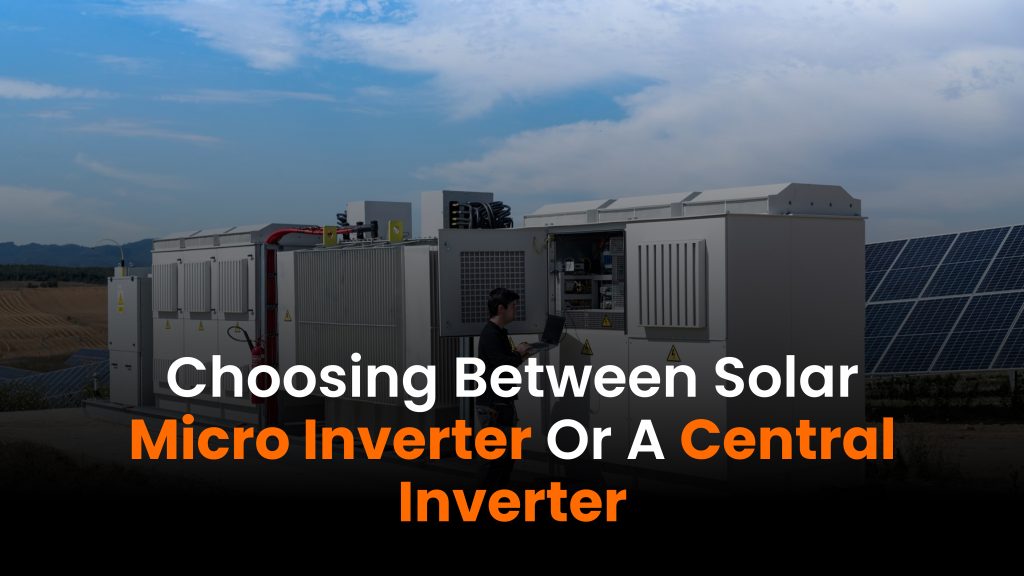Inverters play a crucial role in every solar energy system.They convert the direct current (DC) produced by solar panels into the alternating current (AC) that powers your home. Traditionally, central inverters—also called string inverters—have been the standard. However, Solar micro inverters have emerged as a strong competitor, especially in residential applications. Let’s take a closer look at the pros and cons of each type.
Central Inverters: Reliable and economical
Central inverters are tried-and-true. Their widespread use over the years has earned them a reputation for reliability and cost-effectiveness. These systems typically offer:
- Proven Track Record: Central inverters have been around for decades, with efficiency rates reaching up to 95%. Their performance is well-documented, providing homeowners and investors with confidence in their reliability.
- Cost Savings: As a single device managing the entire solar array, central inverters are more affordable upfront compared to micro inverters.
- Simplicity: With fewer components, central inverters are easier to manage and maintain, reducing the complexity of the system.
Drawbacks of central inverters
Despite their benefits, central inverters have limitations:
- Shading Sensitivity: If just one solar panel in a central inverter system is shaded, even partially, it can reduce the output of the entire array by as much as 50%. This makes central inverters less ideal for roofs with shading issues.
- Safety Concerns: Central inverters require high-voltage DC electricity to travel from the panels to the inverter. This can pose a safety risk during maintenance or in emergency situations, as the panels continue to generate electricity even when the inverter is off.
- Limited Scalability: Expanding your solar array can be challenging with a central inverter. Adding more panels may exceed the inverter’s capacity, requiring you to purchase an additional unit—a costly and inconvenient solution.
- Monitoring Limitations: Central inverters provide system-wide performance data but don’t offer insights at the individual panel level. This can make it harder to pinpoint issues with specific panels.
Micro Inverters: A new era of efficiency
Micro inverters have revolutionized the solar market by addressing many of the shortcomings of central inverters. These smaller devices are installed on each panel, converting DC to AC electricity right at the source.
Benefits of Solar Micro Inverters
- Shade Resilience: One of the biggest advantages of micro inverters is their ability to isolate panel performance. If one panel is shaded, it doesn’t impact the output of the others. This makes micro inverters an excellent choice for homes with partial shading.
- Enhanced Safety: By converting DC to AC at the panel level, micro inverters operate at lower voltages, significantly reducing safety risks.
- Scalability: Expanding your solar system is easy with micro inverters. Simply add more panels, and each new panel gets its own micro inverter—no need to upgrade a central unit.
- Advanced Monitoring: Micro inverters allow for detailed monitoring at the panel level. Homeowners can track the performance of individual panels, making it easier to identify and resolve issues.
- Potential for Higher Energy Yield: Proponents of micro inverters argue that these systems can harvest 5–20% more energy over their lifetime compared to central inverters, thanks to their ability to optimize each panel’s output.
Considerations for Solar micro inverters
Micro inverters aren’t without their downsides:
- Higher Initial Cost: Micro inverters are more expensive upfront due to the need for one inverter per panel. However, their long-term benefits, such as improved efficiency and scalability, can offset the initial investment.
- Complexity: With more components, micro inverter systems may require additional time and expertise for installation and maintenance.
Central vs. Micro: which should you choose?
Both central and micro inverters have a place in the solar market, and the choice depends largely on your specific needs:
- Central Inverters: Best for large, open solar arrays with no shading issues. They’re also ideal for commercial and utility-scale projects due to their cost-effectiveness and simplicity.
- Micro Inverters: Perfect for residential installations, especially for homes with shading concerns or plans to expand the system over time. They’re also a safer and more flexible option for households prioritizing monitoring and performance.
The micro inverter market: A rising star
Micro inverters have gained significant traction in the residential sector, with Enphase Energy leading the charge. Enphase dominates the market with high-performance products and a solid reputation.
However, competition is heating up. Companies like Enecsys and SolarBridge are entering the scene with innovative offerings, such as higher DC-to-AC conversion rates and longer warranties. For example:
- Enecsys: Claims a full 360W DC-to-AC conversion rate, providing impressive efficiency.
- SolarBridge: Offers slightly higher conversion rates and extended warranties, appealing to cost-conscious consumers.
- GreenRay: Takes a unique approach by integrating micro inverters directly into solar panels, reducing installation complexity.
While these challengers are making strides, Enphase remains the gold standard for now. It’s worth keeping an eye on the market as new technologies emerge.
Conclusion
Choosing between central and micro inverters comes down to your priorities. Central inverters are a time-tested solution with a lower upfront cost, making them a great option for large-scale systems without shading concerns. On the other hand, micro inverters offer unparalleled flexibility, safety, and efficiency, making them a popular choice for residential installations.
As micro inverter technology continues to evolve, the potential for even greater energy yields and advanced monitoring capabilities will only grow. By understanding the strengths and weaknesses of both options, you can make an informed decision that aligns with your energy goals and budget.
No matter which path you choose, embracing solar energy is a step toward sustainability and long-term savings—a win for your wallet and the planet.

